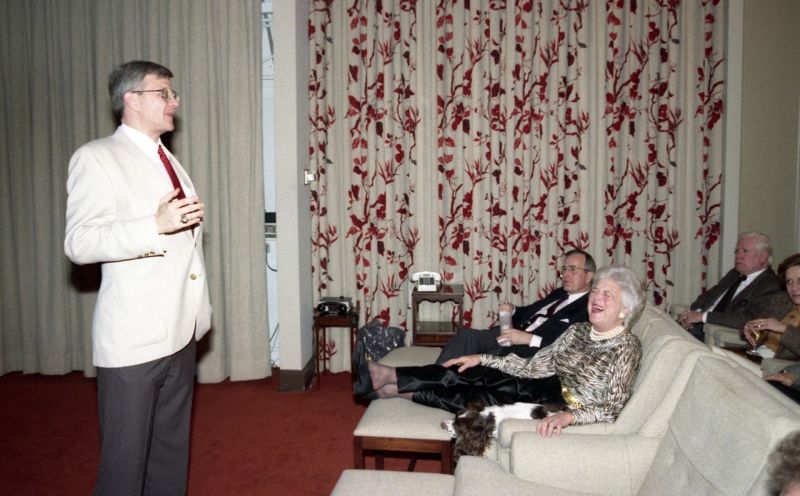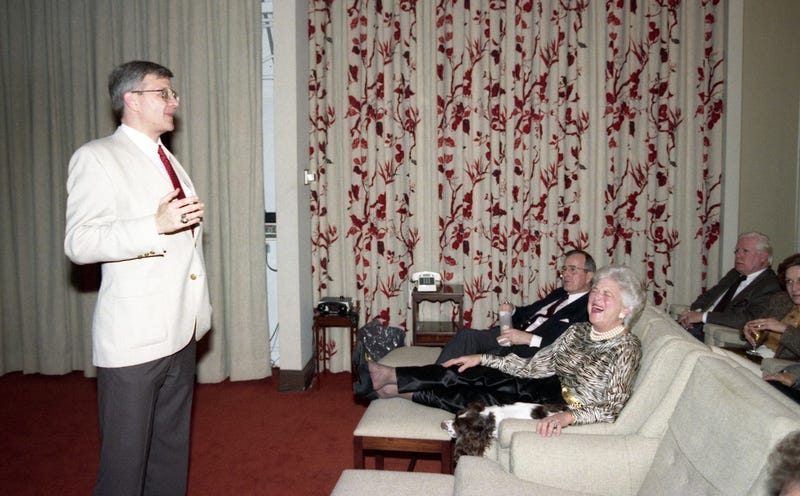
President George H. W. Bush hosted a star-studded screening of The Hunt for Red October at the White House on February 19, 1990. The guests included everyone from Tom Clancy and James Earl Jones to the CEO of Paramount and Colin Powell. Robert Gates was there, as was the director of the CIA, and men from the highest ranks of the Navy. But there are some guests who still remain a secret, even to this day.
I obtained photos of the movie screening through a Freedom of Information request to the George Bush Presidential Library. And the photos that have been withheld are nearly as interesting as the photos I got.
It’s sort of a surreal event to imagine, in retrospect. The Hunt for Red October, based on Tom Clancy’s 1984 book of the same name, is notable for being the last American film produced about the Cold War during the Cold War. And this gathering of Hollywood elites and the National Security establishment could almost be seen as both a victory lap for the Cold War and a pre-game meeting for the first Gulf War.
Advertisement
The Hunt for Red October started production in April of 1989, but by the time it hit theaters on March 2, 1990, the Berlin Wall had come down (November 1989) and the Soviet government announced that the Communist Party was no longer in control.
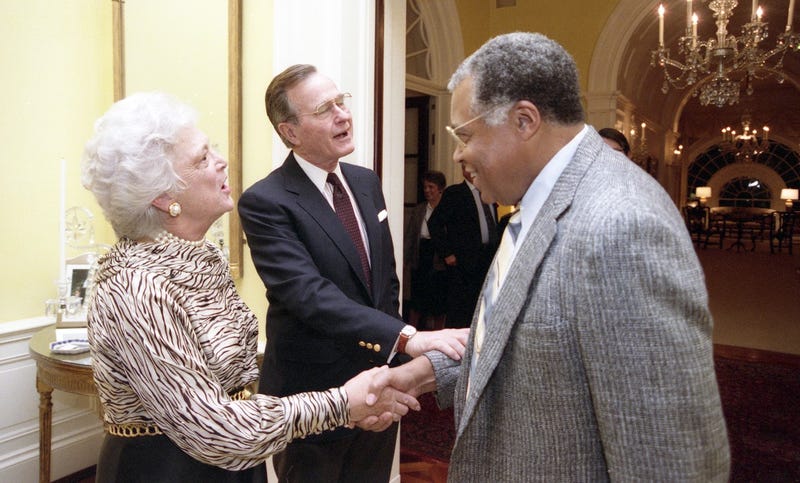
The plot centers around the possible defection of a high-ranking Soviet submarine captain played by Sean Connery. A lone CIA analyst, played by Alec Baldwin, is the only person who understands that this Soviet commander wants to defect with his new high-tech sub, rather than bomb Washington. Baldwin’s character must convince his pals in the Navy that Connery’s character poses no threat. But just as Soviet-American comedian’s Yakov Smirnoff’s career ground to a halt after the collapse of the Soviet Union, the idea of high-stakes defection was almost a punchline by 1990.
Sponsored
If you saw The Hunt For Red October in theaters, you knew that the Cold War was effectively over. And that made producers nervous. Originally set loosely in what was then “present day,” Paramount Pictures even had to add a text crawl at the beginning of the film to firmly place it in the past: “On November 13, 1984, approximately four months before Mikhail Gorbachev took power in the Soviet Union…”
But Americans loved it. The people of 1990 experienced a sort of instant nostalgia for steely men making tough decisions about the potential for nuclear apocalypse. It wound up being the sixth highest grossing movie of 1990—beaten by Home Alone, Ghost, Dances with Wolves, Pretty Woman, and Teenage Mutant Ninja Turtles, in that order. And it was cemented into the public imagination as a solid win for both the Navy and the CIA.
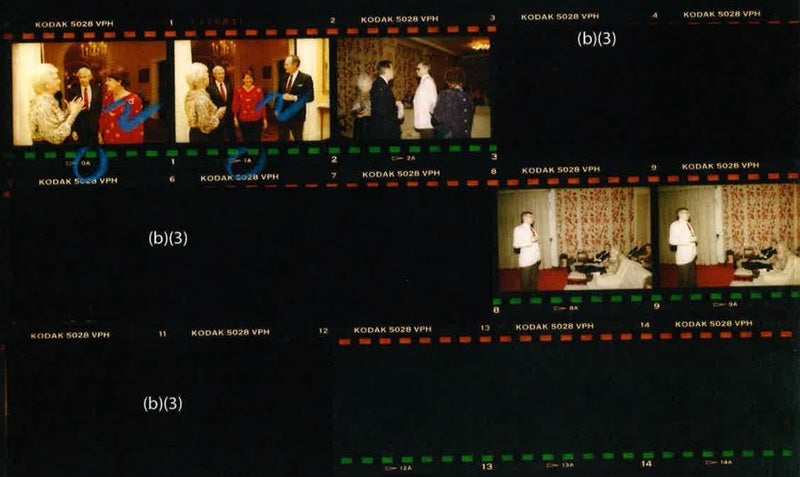
As I mentioned, the photos that have been withheld from my FOIA request hammer at the WHAT ARE YOU HIDING button in my brain. I read heavily redacted government documents all the time. But there’s something about the power of redacted photos from a contact sheet that’s even more alluring. You see those “(b)(3)“ redactions above? Those are presumably photos of CIA agents, and perhaps some people like Robert M. Gates, future Secretary of Defense for both George W. Bush and Barack Obama.
Advertisement
It has been incredibly common since Jimmy Carter’s presidency to use the White House screening room as a way to entertain high-profile guests. Bush would host numerous movie screenings during his presidency, just as President Clinton would after him.
Bush had Arnold Schwarzenegger and Maria Shriver over to see Dirty Rotten Scoundrels on February 18, 1989. He had Gary Shandling and Linda Doucett at the White House for a screening of the long forgotten Michael Keaton vehicle The Dream Team on April 29, 1989. But there was something special about this movie get-together and the CIA and military attendees. The Navy was so intimately involved in the production of The Hunt For Red October. They supplied consultants and allowed filming on aircraft carriers at no cost to the production company.
The question that remains is how deeply involved the CIA was in advising the producers of The Hunt For Red October. The CIA didn’t have a formal entertainment industry liaison office until 1995—five years after The Hunt For Red October was released. And the fact that viewers never see the CIA’s official seal in the movie lends credence to the idea that the agency didn’t have any official involvement with the film. But we’re not so sure. The CIA infamously helped finance the 1954 animated adaptation of George Orwell’s Animal Farm.
One attendee at the White House for The Hunt For Red October might have seen the potential that night for using film as a way to give the public a better impression of the CIA. That man was Robert M. Gates, then the Deputy Assistant for National Security Affairs.
In the 2009 paper “Get Smart: A Look at the Current Relationship Between Hollywood and the CIA” by Tricia Jenkins, we learn about Gates and his attempts at transparency following the screening. Roughly a year later, as Director of Central Intelligence, Gates would create the Task Force For Greater CIA Openness. The document recognized the need for greater transparency by the CIA—an agency that had a less than sterling reputation for openness with the American public.
Part of that bid for transparency was to declassify more documents and open up the archives, so that the world could get a better sense of what the CIA had accomplished. The other side was getting more intimately involved with the media; a move that might be seen with more cynical eyes as government propaganda overtly penetrating film and TV production.

But after that winter screening in 1990, what was next? How would America flex and pose on the world stage militarily with the collapse of their greatest foe? America wouldn’t let those war muscles atrophy, of course, as Saddam Hussein’s spanking would be delivered less than a year later. And slowly but surely, the National Security establishment would learn how to use American popular media to its advantage. The first bombings of the Gulf War were timed to coincide with the US evening news.
Strangely enough, this White House screening was tangentially involved in a sex scandal that would only surface nearly two decades later. Naval aide John Stufflebeem was there at the February 1990 screening with his wife. In 2008 he was fired as a director of Navy staff after it came to light that he had an affair with a federal employee that started in 1989—or, by his recollection, a non-sexual relationship that started the same month as The Hunt For Red October screening.
Stufflebeem, who would work his way up to Rear Admiral in the following years, allegedly told the unnamed woman (only known as Jane Doe in the court documents) that his wife had passed away, which was untrue. According to the US Department of Defense Inspector General’s report, they had engaged in sexual relations many times, including at least one romp session somewhere inside the White House.

When Jane Doe found out that Stufflebeem was married, she was reportedly livid, leading us to believe that if her version of events is true, she wasn’t at the screening of The Hunt For Red October.
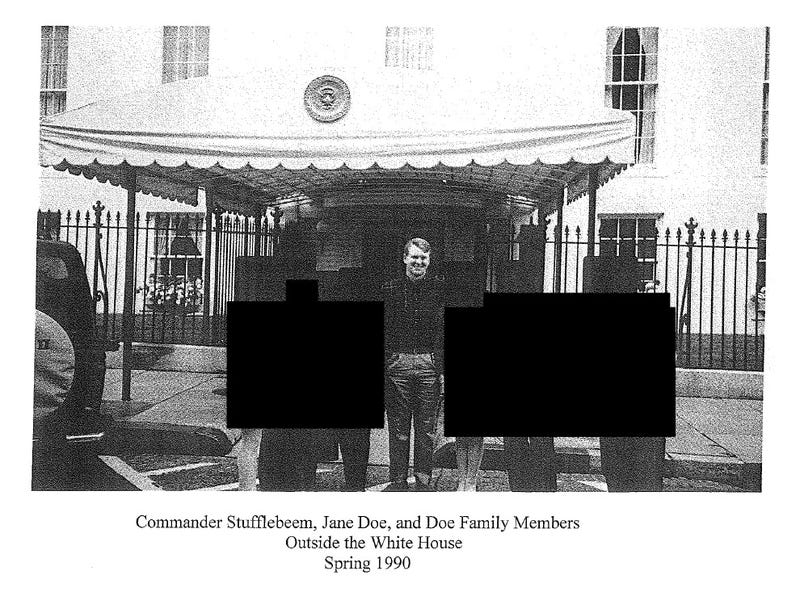
I’m still compiling what I hope will be a comprehensive list of the movies George H.W. Bush watched while in office, as I have with President Carter and President Clinton. But that will require a bit more digging, as I get a broader picture of not only what Bush watched, but how it influenced the way that government would use the power of film to influence the American people.
Below is the complete guest list for the screening of The Hunt For Red October. I’ve included screenshots of the redacted portions and transcribed the rest of the list verbatim:
Barbara Bush, The First Lady
Marvin P. Bush, the President’s son
Mrs. Marvin P. (Margaret) Bush, the Presidents daughter-in-law

Thomas L. Clancy Jr., author
Mrs. Thomas L. (Wanda) Clancy, wife
Martin S. Davis, Chairman of the Board and Chief Executive Officer, Paramount Communications, Inc., New York, New York.
Mrs. Martin S. (Luella) Davis, wife
Robert M. Gates, Deputy Assistant for National Security Affairs
Mrs. Robert M. (Rebecca) Gates, wife
Cdr. James C. Holloway, guest attending
Mrs. James C. (Beverly) Holloway, wife
Adm. James L. Holloway III, U.S. Navy retired
Mrs. James L. (Dabney) Holloway III, wife
Adm. Bobby R. Inman, former Deputy Director of the Central Intelligence Agency (CIA)
Mrs. Bobby R. (Nancy) Inman, wife
James Earl Jones, actor
Adm. Frank Kelso II, Commander in Chief, U.S. Atlantic Command
Mrs. Frank (Landess) Kelso II, wife
Richard J. Kerr, Deputy Director, Central Intelligence Agency (CIA)
Mrs. Richard J. (Janice “Jan”) Kerr, wife

Virginia A. Lampley, Special Assistant for National Security Affairs and Senior Director for Legislative Affairs
Frederic V. Malek, Senior Advisor of the Carlyle Group, Washington, D.C.
Mrs. Frederic V. (Marlene) Malek, wife
Adm. Daniel J. Murphy, partner with Murphy and Demory Ltd.
Sharon Norris, guest attending

Gen. Colin L. Powell, Chairman, Join Chiefs of Staff (JCS)
Mrs. Colin L. (Alma) Powell, wife
Davis R. Robinson, husband of the President’s first cousin, Susue Walker
Mrs. Davis R. (Suzanne “Susue”) Robinson, wife and the President’s first cousin
Brent Scowcroft, Assistant for National Security Affairs
Cdr. John P. Stufflebeem, Naval Aide
Mrs. John P. (Nan) Stufflebeem, wife
John H. Sununu, Chief of Staff
Mrs. John H. (Nancy) Sununu, wife
Adm. Carlisle A.H. Trost, Chief of Naval Operations
Mrs. Carlisle A. H. (Pauline) Trost, wife
James D. Watkins, Secretary of Energy
Mrs. James D. (Sheila) Watkins, wife
William H. Webster, Director, Central Intelligence Agency (CIA)
Alan Wolfe, guest attending
Mrs. Alan (Ann) Wolfe, wife

